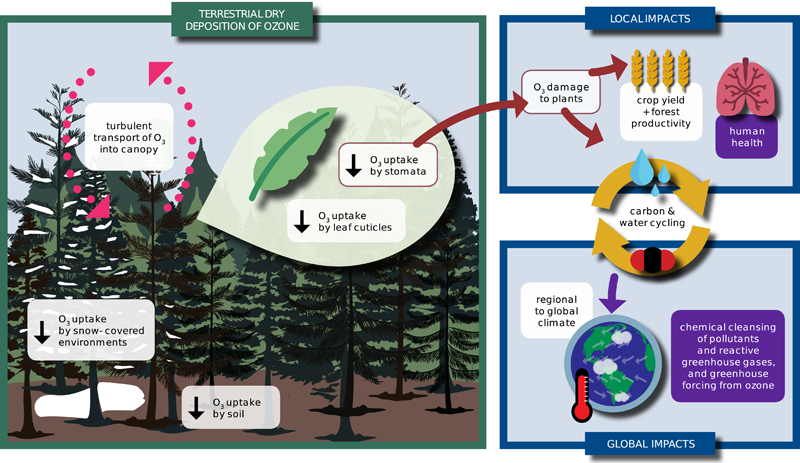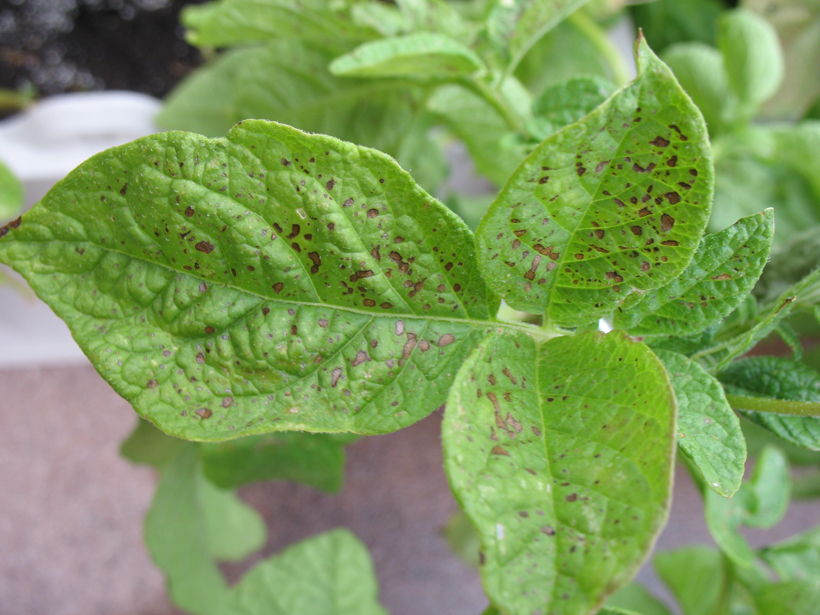“Dry deposition” is the process by which ozone is removed from the atmosphere at Earth’s surface. It’s an important process to understand because it impacts air pollution, ecosystem health, and climate. A recent article in Reviews of Geophysics presented the current state of knowledge on ozone dry deposition. Here, one of the authors gives an overview of ozone dry deposition processes, and how they are measured and modeled.
How and where does dry deposition happen?
Dry deposition of ozone happens when turbulent air motions bring ozone close to a surface, and then ozone reacts with that surface.
Dry deposition of ozone happens when turbulent air motions bring ozone close to a surface, and then ozone reacts with that surface.
Dry deposition is analogous to wet deposition, another removal pathway for many atmospheric compounds (but not ozone) happening when rain removes the compounds from the atmosphere.
Important surfaces to which ozone dry deposits include vegetation, soil, and snow. There are multiple pathways by which ozone deposits to vegetated surfaces. We classify these pathways as either ‘stomatal’, when ozone is taken up by plant stomata (the small pores on plant leaves used for gas exchange), or ‘nonstomatal’, when ozone deposits to other parts of the plant canopy.
Why is it important to understand and quantify these processes?
There are a few reasons. First, dry deposition removes ozone from the troposphere, the atmospheric layer where weather happens. In the troposphere, ozone is an air pollutant, a greenhouse gas, and central to the removal of many pollutants and reactive greenhouse gases through chemical oxidation. Knowing how much ozone is deposited helps us to quantify how much ozone is in the troposphere. There is also evidence that day-to-day changes in ozone dry deposition influence high versus low ozone pollution days.
Second, plants can be harmed when ozone deposits inside stomatal pores. When plants open their stomata to take up carbon dioxide for photosynthesis, ozone gets inside the leaf and reacts with internal fluids and tissues. These reactions cause plants to stress, impacting their ability to photosynthesize. We need to understand and quantify stomatal ozone dry deposition to estimate the damages incurred by vegetation, including crops, from ozone pollution.
Third, the stomatal depositional pathway for ozone is linked with regional-to-global water and carbon cycling as these gases are exchanged through the stomata alongside ozone. If plants are damaged by ozone, the ability of the plant to accumulate carbon and transpire can be compromised. Understanding linkages between ozone pollution and water and carbon cycling requires us to quantify the stomatal portion of ozone dry deposition.

How is it measured and how accurately can it be quantified?
Ozone dry deposition is best measured through the eddy covariance technique. For this technique, you need fast measurements of ozone concentrations and vertical wind over the surface you wish to investigate. The covariance between the ozone concentration and vertical wind gives you a measure of how much ozone was lost to dry deposition to the surface underneath your ozone and wind instruments. The measurement is pretty accurate, although it has limitations during times of low wind and over non-flat terrain or vegetation. Another issue is that very fast ozone chemistry in the air beneath the instruments can look like ozone dry deposition, and so you must be able to separate dry deposition from ambient chemistry.
How does ozone dry deposition vary over time and between places?
Ozone dry deposition changes quickly over the course of a day, as well as from day to day, one season to the next, and year to year.
We need more sites with longer ozone dry deposition measurements to understand how ozone dry deposition varies over time and between places. There are only a couple of sites around the world with more than a few years of data. These datasets suggest ozone dry deposition changes quickly over the course of a day, as well as from day to day, one season to the next, and year to year.
There appear to be differences in ozone dry deposition between places, but it’s hard to understand how differences in meteorology or vegetation between places drive these differences without long-term ozone dry deposition measurements at a coordinated network of sites.
In general, the exact drivers of variability in ozone dry deposition, especially in nonstomatal deposition, are uncertain. This uncertainty prevents us from modeling variability in ozone dry deposition accurately, hindering a full understanding of ozone air pollution and the associated plant damage.

What aspects ozone dry deposition are well-understood and which are less certain?
From our review of the current knowledge in this field we think that nonstomatal deposition may be more important than previously recognized. In general, stomatal deposition is better understood than nonstomatal deposition. The topic of stomatal functioning is relevant for regional-to-global carbon and water cycling and forest and crop productivity so we can build our understanding of stomatal ozone dry deposition from studies from other fields like plant physiology and ecology. While laboratory and field studies indicate that nonstomatal deposition can vary with environmental conditions and contribute to a sizeable fraction of the total ozone dry deposition, the magnitude and temporal variability of nonstomatal ozone dry deposition at any given place is uncertain.
More laboratory research and long-term field data are needed.
The main need in terms of research going forward is for more laboratory research and long-term field data, as well as syntheses of old data, to learn how to translate our current understanding of contributing processes into an ozone dry deposition parameterization for regional-to-global models.
What are some of the benefits and challenges of synthesizing research from different fields such as atmospheric chemistry, ecology, and meteorology?
For an interdisciplinary topic like ozone dry deposition there are many benefits from synthesizing research from different fields.
For an interdisciplinary topic like ozone dry deposition there are many benefits from synthesizing research from different fields. Something well understood in one field is not necessarily known in another, so it’s important to solidify a knowledge base across fields. Because ozone dry deposition is so dependent on the land surface, we wouldn’t get very far in advancing understanding without leveraging decades of knowledge from biometeorological and plant physiological research.
However, it can be challenging to get everyone on the same page because terminology and overarching research questions differ across fields. Generally, it’s also hard to meet and establish collaborations with folks in other fields. This review paper was an outcome of a workshop in 2017 at Lamont Doherty Earth Observatory. Funding for this workshop from the Lamont Climate Center, NOAA, and NASA allowed us to invite people from a variety of different fields and initiate collaborations for the review paper. It is through interdisciplinary initiatives like these that we can advance our understanding.
—Olivia Clifton ([email protected]; ![]() 0000-0002-1669-9878), National Center for Atmospheric Research, Colorado, USA
0000-0002-1669-9878), National Center for Atmospheric Research, Colorado, USA
Citation:
Clifton, O. (2020), Removal of ozone air pollution by terrestrial ecosystems , Eos, 101, https://doi.org/10.1029/2020EO144521. Published on 01 June 2020.
Text © 2020. The authors. CC BY-NC-ND 3.0
Except where otherwise noted, images are subject to copyright. Any reuse without express permission from the copyright owner is prohibited.

